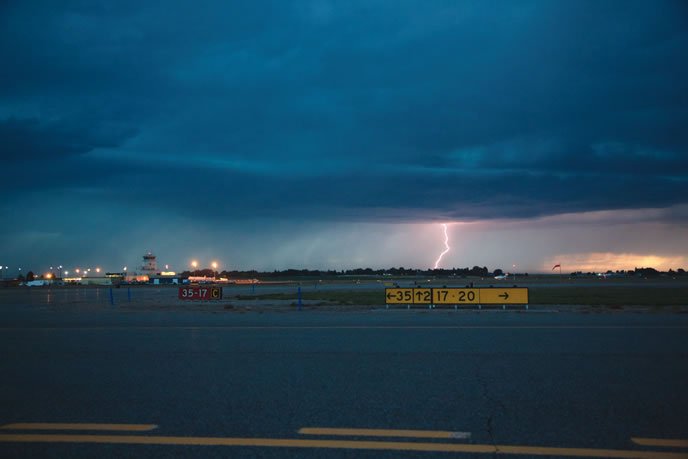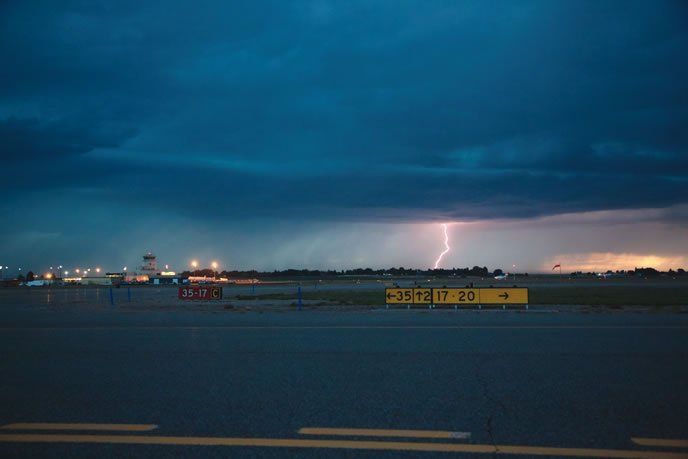Lightning always gets your attention. It should. On average, 51 people die in the U.S. each year from lightning strikes, making it the second-most common cause of storm-related deaths in the country, behind only floods. Hundreds more people are struck by lightning each year in the U.S., resulting in significant injury.
Lightning strikes, however, mostly affect people on the ground and generally cause little to no injury to pilots in the air despite NOAA estimates that there are about 25 million lightning strikes in the U.S. each year.

Strikes Happen
In fact, the FAA estimates each commercial airliner is hit once a year, which jibes with statistics from the French Office National d’Etudes et Recherches Arospatiales (ONERA, the country’s aeronautics, space and defense research lab) showing an airliner is struck by lightning every 1000 flight hours. The smaller general aviation aircraft you and I fly are struck much less frequently, primarily due to their limited operations around thunderstorms. And if your ride does suffer a lightning strike while you’re aboard, there can be a variety of effects.
For example, the metallic skin and structure of most aircraft protects the occupants and routes the electrical energy through it and back out into the atmosphere. Modern avionics, meanwhile, are designed to withstand typical lightning-induced surge effects, but transient electric effects can disable or damage electronic equipment. The locations where a bolt enters or exits an aircraft can damage the aircraft’s skin, but damage is typically not catastrophic. The incidents where lightning has brought down a plane, shut down an engine, structurally damaged a control surface or physically impaired either avionics, or a crew member, are rare outliers. That doesn’t mean you should think the rarity of lightning-induced in-flight emergencies gives you permission to ignore it. After all, it most often isn’t the lightning itself that affects the aircraft but the associated storm.
What causes lightning?
Lightning is the spontaneous flow of electrons seeking equilibrium, either from cloud-to-cloud or from cloud-to-ground. While the exact mechanisms are not fully understood, the static electrical charges known to build in cumulonimbus clouds are likely caused by the collision and vertical movement of air containing dust, ice and water particles. Friction and rapid movement generates the charge. Smaller particles (water drops and ice crystals) become positively charged while the larger particles (dust and atmospheric particulates) become negatively charged. Convective uplift results in significant separation of charge with heavier negatively charged particles at the base of the cloud and a positive charge rising toward the cloud top.
The most common type of lightning discharge is “negative” cloud-to-ground. It accounts for 90 percent of all lightning strikes. The negative charge at the base of a cloud begins moving toward the ground forming an invisible conductive path, known as a step lead. The stepped leader is an advancing column of ionization that intermittently zig-zags its way to the ground (or a zone of opposite charge in another cloud). Step leaders typically move in 50m increments. As this preferential charge path of the step lead nears the ground, the negative channel of charge attracts streamers of positive charge that move upward from the ground (often from taller objects in the immediate area). Negative lightning occurs when the downward step lead meets the upward traveling positive streamer. This is the connection that gives way to a lightning flash.
The millisecond event of an actual lightning bolt is bi-directional. With the circuit completed, the electrical current of a lightning bolt flows up the channel of the combined negative step lead and positive streamer into the cloud resulting in return stroke back down. The return stroke is what we call lightning. Lightning typically flickers with multiple strokes down the same step lead pathway. In other words, lightning absolutely strikes in the same place more than once.
Positive lightning, where the positive charge in the upper part of a cloud connects to the ground, follows a similar mechanism except the charge is reversed. Positive charges high in the storm form the step lead. Since it is further removed from the ground, it takes a great deal more power to connect the circuit. Therefore, positive lightning from the cloud tops to the ground carries much more energy when the circuit is completed. The proverbial “bolt out of the blue” is often positive lightning.
An average strike releases thousands of amperes of electricity or about five billion joules of electrical energy (1.4 megawatt hours of electricity) in a few milliseconds and can generate high-energy x-rays, gamma rays, beams of charged particles and even antimatter. Rapid heating of the air to a 50,000-degree plasma creates a blinding flash of light, followed by rapid cooling that creates a shockwave we call thunder. In other words, the energy exchange of a lightning flash is awesome. It’s almost the stuff of science fiction.
Entry And Exit
Certified aircraft designs help assure a direct strike has little chance of affecting critical components or aircraft occupants. Most aircraft have either metal skins that naturally conduct current or composite materials incorporating a conducting mesh designed to channel lightning’s electrical energy. Just as an umbrella protects someone from rain, the Faraday cage of a conductive aircraft skin protects an airplane’s occupants from stray electrical charge by providing a much easier pathway for the electrons to enter and exit. Because electric charges typically move along conductive surfaces, aircraft designers use bonding strips to connect all the aircraft sections to ensure charges flow evenly in the event of a lightning strike. Static wicks are used to dissipate or direct electrical charge away from control surfaces.
Even with good bonding, lightning can find sharp points to jump or transfer energy flow. Sharply pointed extremities like wingtips, rudder tips and aileron corners are vulnerable to damage. Composite structures require additional thought and design to protect them from lightning. Since lightning can be fickle and exit an airframe at a point of its own choosing, any aircraft that’s been struck should get a thorough examination at the earliest safe opportunity.
Effects
In addition to possible entry and exit wounds, lightning has great potential to affect electronic systems. When an electrical current of lightning passes across an aircraft skin, it creates a magnetic field that rapidly expands and collapses. This field can induce current surges in avionics, resulting flickers, software resets or even complete failures. While certified avionics systems are designed to be tolerant of such electrical transients, they are not completely immune from failure.
Pilots also need to know the flash/bang from lightning can cause temporary blindness (particularly at night) as well as temporary hearing impairment. Jet jockeys should know the shockwave, which humans perceive as thunder, generated at the aircraft surface is capable of flaming out a jet engine, though this typically only happens on the side of the aircraft that is struck and rarely affects multiple engines.
Although there are some exceptions where a plane’s occupants have became part of the circuit of lightning passing through the aircraft, humans and cargo generally are protected in the aircraft’s Faraday cage.
An Excellent Risk Indicator
None of which is to say lightning isn’t useful. Pilots should view lightning as a good indicator that the weather is about to go beyond the limits of reasonable flying. It should carry a mental association with hail, damaging winds, wind shear, and the strong updrafts and downdrafts of a building thunderstorm. Avoiding a supercell producing 800 strikes per minute should be a no-brainer. The same goes for any mid-continent, fast-moving convective cold front with tops in the 30-60,000-foot range. Thunderstorms are serious business and the standard recommendation is to stay a healthy distance (20-25NM) away from them.
The best way to avoid lightning’s risk is to avoid thunderstorms altogether. My 1954 Cessna 180 is rare in that its original skin has no hail damage, and I want to keep it that way, so I steer well clear of the big stuff. But not all storms are created equal. What about smaller storms and transitional weather?
The possibility of lightning strikes is a legitimate concern when transitioning through building or marginal weather. A typical scenario for active pilots is a long cross-country (with 3-4 hour legs) where you need to cross one or more wide regions of instability. The challenge is transitioning through the building weather systems to reach stability on the other side of a front for example. There may be no convective Airmets or Sigmets, but atmospheric instability means there may be isolated or scattered thunderstorms along a route forecast as VFR.
From the air, scattered and isolated thunderstorms can be manageable. If you can get through a system before it builds, you can put it behind you. Planes can almost always outrun weather. Storm cells often appear as easily avoided patches of cumulus youngsters with a few showing streaks of rain coming from bases that are 5-10K above the ground. As the day wears on, these adolescents start showing signs of cumulonimbus puberty. Lightning is the first sign of teenage rebellion. This is where GA pilots may get into a world of hurt.
Enlightenment
Continuing into a weather system producing lightning puts you at risk to a thunderstorm’s other characteristics. My rule of thumb for approaching and passing through building weather systems is to remain in visual conditions and never pass into veils or curtains of cloud or precipitation if you can’t clearly see what’s behind them. If you see lightning, thoughts of downdrafts, hail and general nastiness should enter your mind. The first strike should immediately prompt you to seek your safest path around the cell.
You have several options to choose from. It may be best to turn tail and run away or head off at 90 degrees. Or, if no safe path can be found, it may be time to land, though remember the greater danger from lightning is on the ground, so landing in the immediate vicinity of a storm may not be your best option. In some cases, your best option may be continuing through to the other side, but that’s only a good choice if you determine you can do so expeditiously while remaining in VFR and clear of turbulence and serious precipitation. When you are passing through building weather systems, conditions often can be worse behind you. Don’t let this pressure push you to continue into a storm you can’t see through. If there is an available airport nearby, use it before things go from bad to worse. It may be safer to strike the trip than streaking along into a striking storm.
Mike Hart recently flew his Cessna 180 3500 nm across the U.S. and back in unstable May weather requiring five hours of hard IMC and several days waiting out weather.




